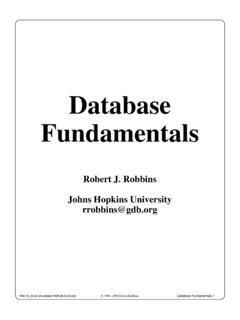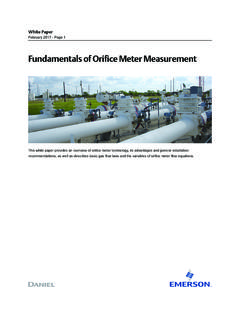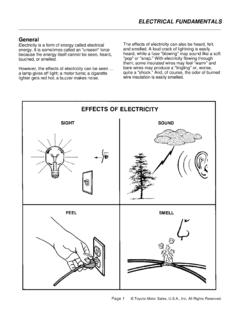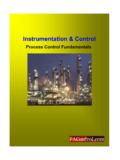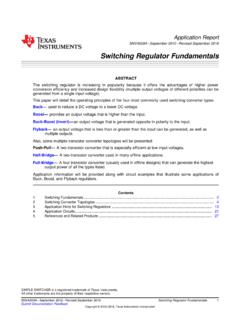Transcription of HVAC Engineering Fundamentals: Part 1
1 Source: hvac Systems Design Handbook Chapter hvac Engineering fundamentals : 1. part 1. Introduction This chapter is devoted to fundamental'' fundamentals certain prin- ciples which lay the foundation for what is to come. Starting with the original author's suggested thought process for analyzing typical prob- lems, the reader is then exposed to a buzzword of our time: value Engineering . Next follows a discussion of codes and regulations, polit- ical criteria which constrain potential design solutions to the bounds of public health and welfare, and sometimes to special interest group sponsored legislation.
2 The nal sections of the chapter offer a brief review of the basic physics of heating, ventilating, and air conditioning ( hvac ) design in discussions of uid mechanics, thermodynamics, heat transfer, and psychrometrics. Numerous classroom and design of ce experiences remind us of the value of continuous awareness of the physics of hvac processes in the conduct of design work. Problem Solving Every hvac design involves, as a rst step, a problem-solving pro- cess, usually with the objective of determining the most appropriate type of hvac system for a speci c application.
3 It is helpful to think of the problem-solving process as a series of logical steps, each of which must be performed in order to obtain the best results. Although there are various ways of de ning the process, the following sequence has been found useful: 1. De ne the objective. What is the end result desired? For hvac . the objective usually is to provide an hvac system which will control 1. Downloaded from Digital Engineering Library @ McGraw-Hill ( ). Copyright 2004 The McGraw-Hill Companies. All rights reserved. Any use is subject to the Terms of Use as given at the website.
4 hvac Engineering fundamentals : part 1. 2 Chapter One the environment within required parameters, at a life-cycle cost com- patible with the need. Keep in mind that the cost will relate to the needs of the process. More precise control of the environment almost always means greater cost. 2. De ne the problem. The problem, in this illustration, is to select the proper hvac systems and equipment to meet the objectives. The problem must be clearly and completely de ned so that the proposed solutions can be shown to solve the problem. 3. De ne alternative solutions.
5 Brainstorming is useful here. There are always several different ways to solve any problem. If re- modeling or renovation is involved, one alternative is to do nothing. 4. Evaluate the alternatives. Each alternative must be evaluated for effectiveness and cost. Note that doing nothing'' always has a cost equal to the opportunity, or energy, or ef ciency lost'' by not doing something else. 5. Select an alternative. Many factors enter into the selection process effectiveness, cost, availability, practicality, and others. There are intangible factors, too, such as an owner's desire for a par- ticular type of equipment.
6 6. Check. Does the selected alternative really solve the problem? 7. Implement the selected alternative. Design, construct, and op- erate the system. 8. Evaluate. Have the problems been solved? The objectives met? What improvements might be made in the next design? Many undertakings fail, or are weak in the end result, due to failing to satisfy one or more of these problem-solving increments. There is an art in being able to identify the key issue, or the critical success factors, or the truly bene cial alternative. Sometimes the evaluation will be clouded by constraint of time, budget, or prejudice.
7 Occasion- ally there is an error in assumption or calculation that goes un- checked. The best defense against disappointment is the presence of good training and good experience in the responsible group. Value Engineering Value analysis or value Engineering (VE) describes a now highly so- phisticated analytical process which had its origins in the materiel shortages of World War II. In an effort to maintain and increase pro- duction of war-related products, engineers at General Electric devel- oped an organized method of identifying the principal function or ser- vice to be rendered by a device or system.
8 Then they looked at the current solution to see whether it truly met the objective in the sim- plest and most cost-effective way, or whether there might be an alter- native approach that could do the job in a simpler, less costly, or more Downloaded from Digital Engineering Library @ McGraw-Hill ( ). Copyright 2004 The McGraw-Hill Companies. All rights reserved. Any use is subject to the Terms of Use as given at the website. hvac Engineering fundamentals : part 1. hvac Engineering fundamentals : part 1 3. durable way. The results of the value Engineering process now per- meate our lives, and the techniques are pervasive in business.
9 Con- sider our improved automobile construction methods, home appli- ances, and the like as examples. Even newer technologies such as those pertaining to television and computers have been improved by quantum leaps by individuals and organizations challenging the status quo as being inadequate or too costly. Alphonso Dell'Isolo is generally credited as being the man who brought value Engineering to the construction industry, which indus- try by de nition includes hvac systems. Dell'Isolo both wrote the book''1 and led the seminars which established the credibility of the practice of value Engineering in architectural and Engineering rms and client of ces across the land.
10 There is a national professional society called SAVE (Society of American Value Engineers), headquartered in Smyrna, Georgia. The society certi es and supports those who have an interest in and com- mitment to the principles and practices of the VE process. Value Engineering in construction presumes an issue at hand. It can be a broad concern such as a system, or it can be a narrow concern such as a device or component. The VE process attacks the status quo in four phases. 1. Gather information. Clearly and succinctly identify the pur- pose(s) of the item of concern.



